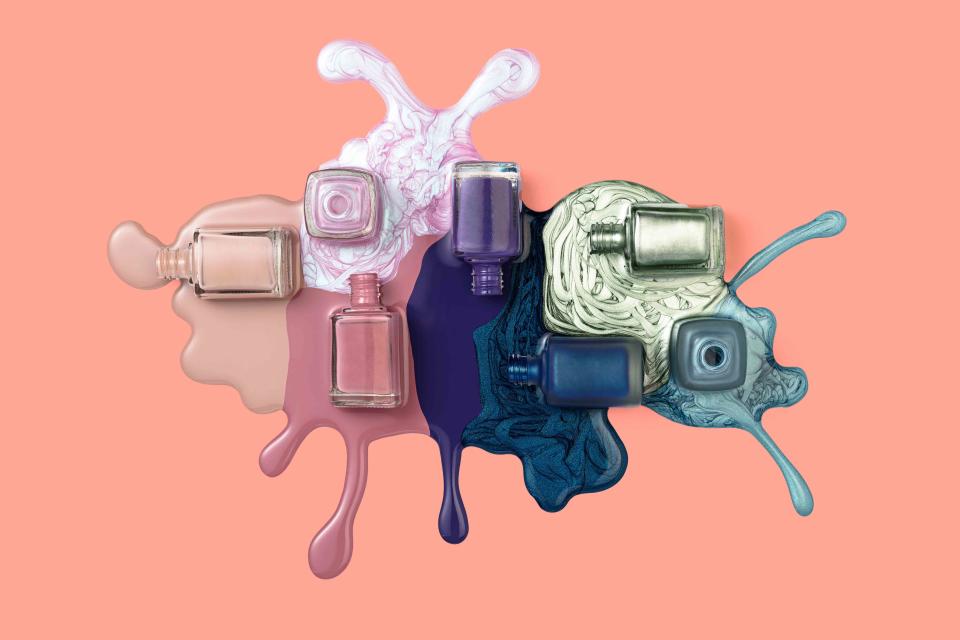Does Nail Polish Expire? Here's How to Tell
The answer may surprise you.

Bonetta/Getty Images
You probably are already aware that there are certain beauty products that can expire—sunscreen, mascara, moisturizer—and that using them past their expiration date is not such a great idea. (If you didn’t, now you know.) But unlike other categories where it may be pretty obvious that something has gone bad, it’s not quite as clear when it comes to nail polish. (Not to mention that we’re all probably guilty of having at least a bottle or two leftover from our college days sitting around somewhere in the bathroom.) But even if your go-to color is past its prime, is there any real drawback to still using it? We asked experts to weigh in so that you can determine whether or not it’s time to toss your beloved bottles.
So, Does Nail Polish Expire?
In a word, yes. The average bottle has a lifespan of about two years, says nail expert Tina Wang, owner of Lunula Salon in Brooklyn, New York. That being said, rather than being married to this hard and fast timetable, it’s more important to consider how often it was used and how it was stored, she adds. Sun exposure and temperature control are two factors that play a role. A polish that was kept consistently in a cool and dry space—the preferred state—will last longer than a polish that was left in direct sunlight with a cap that wasn't fully closed, and perhaps even longer than two years, she explains.
What Happens When Nail Polish Gets Old?
The quality of a nail polish degrades over time: “It won’t spread as well, the pigment won’t be as vibrant, and separation will occur,” explains cosmetic formulator Mary Berry, founder and CEO of Cosmos Labs. This is because nail polish contains solvents that eventually evaporate, causing the remaining ingredients to get thick and not spread as easily; the pigments also start to fade, she adds.
How Can You Tell That Nail Polish is Expired?
While many people use color separation as a standalone indicator that a polish is old, Wang notes that this isn’t always the case. “Polish color separation is a natural occurrence that happens because the ingredients in polish are not all the same density,” she says. (Hence why it’s always good to shake up a bottle before opening it) While that may be a sign, it’s more important to look for other changes in the color and texture, she says. If the hue has changed since you bought it and/or it looks thick and gloopy, it’s likely past its prime. Another huge red flag: If it smells strange or has a strong odor, it’s time to toss it, points out Berry.
It bears mentioning that, unlike many skincare products, nail polishes don’t come with an expiration date on the packaging. If you want to keep tabs on exactly how long you’ve had a bottle, stick a small label on the bottom or cap and note when you bought it.
What Happens If You Use Expired Nail Polish?
Don’t stress, as it’s really not the end of the world. While things such as efficacy and potential bacteria contamination can be a real concern with other products, using old nail polish is most likely to simply result in a less-than-stellar mani. “The main problem with using a polish that’s been open for more than two years is that it won’t yield as good of a user experience. It will probably be thick and hard to put on, and the color might have faded, too,” says Berry. “As polish gets old, it loses the ability to support an even, beautiful application. Fresh polish will apply smoothly and last as long as the manufacturer intended it, whereas old polish may start to peel soon after you apply it,” adds Wang. And while there isn’t a lot of data in terms of the actual physical harm of using expired polish, it’s never a bad idea to avoid any uncertainty and play it safe by simply getting a new bottle, she notes.
For more Real Simple news, make sure to sign up for our newsletter!
Read the original article on Real Simple.

